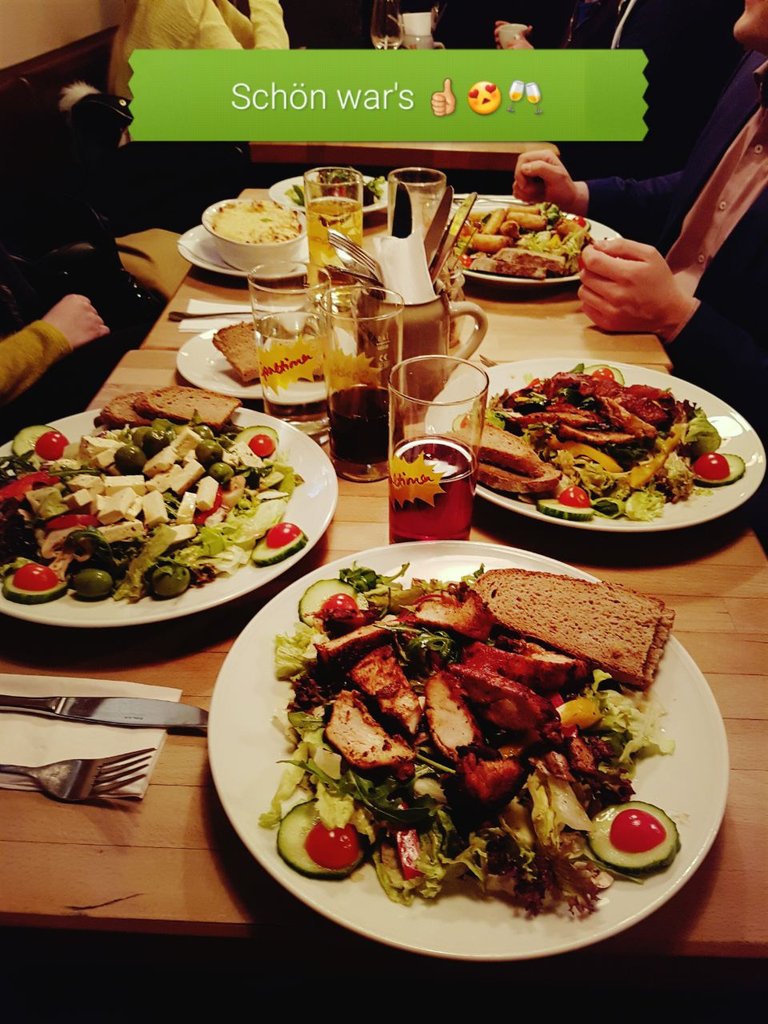
Hello everybody,
my Mum and her Family comes from Poland. I was born in germany. But i feel my polish roots. And i Love the culture there. The people are family, generous and lovely. Sometimes i miss my Family and the people. So i decided to come closer with my feeling to Poland in a Polish Restaurant.
Poland is one of the countries with the highest meat consumption worldwide. But Polish cuisine has more to offer. The bagel comes geographically from Poland and there are many dough products and soups, which belong here to the specialties
For me i found a meal without meat. You find some opportunities :).

I found a salad ;)

In Poland, there are many lakes and rivers, which is why fish plays an important role in Poland's culinary art. In particular, herring, cod and Baltic salmon are roasted, grilled, cooked, pickled or processed into salads.
Meat consumption in Poland is even higher than fish consumption and is one of the highest in the world. In particular, pork is popular in Poland. Rabbit and pheasant are popular wildlife. Goose breeding has a long tradition and Polish oatmeal goose is exported worldwide. Among the many processing options, the preparations with aspic are very popular with meat
My family in Poland don't know what is vegetarian and they would never unterstand it. But it is ok :).
Polish sausages are considered a traditional specialty, but usually have little in common with the varieties known to us. In some areas of Germany, the Krakauer is sold as a long sausage.
Vegetables are thoroughly cooked in Polish cuisine and often covered in bread crumbs, which are fried in butter. This variant has established itself in international cuisine.
Bigos is considered a Polish national dish. It is a stew made with pork, sauerkraut and mushrooms.
Soups are eaten in Poland. Mostly it is based on vegetable broth, to which pork or beef is added. Among the best known are soups with barley, sauerkraut and salt cucumbers. In summer, there are also refreshing cold fruit soups, such as blueberry soup.
Dough products are found in Polish cuisine in different variants. They are a popular accompaniment to meat dishes and soups or are eaten as independent food. The often occurring in Eastern European cuisine dumplings are also available in Poland. They are made in different variations and filled with sauerkraut, mushrooms or meat. Also pasta, pancakes and dumplings are very popular.
In Poland, one often drinks black tea with lemon and sugar. For dining, one of the many Polish beers is served. Also the Polish vodka is very well known. A variant and Polish specialty is Żubrówka. This is a vodka variety made from rye and flavored with bison grass. This gives it a special aroma.
Have you ever taste polish cuisine?
Big kisses,
xoxo Anni
Deutsch / The Same in German

Hallo zusammen,
meine Mutter und ihre Familie kommen aus Polen. Ich bin in Deutschland geboren. Aber ich fühle meine polnischen Wurzeln. Und ich liebe die Kultur dort. Die Leute sind familiär, großzügig und nett. Manchmal vermisse ich meine Familie und die Leute. Also entschied ich mich, Polen in einem polnischen Restaurant näher zu kommen.
Polen gehört zu den Ländern mit dem höchsten Fleischkonsum weltweit. Aber die polnische Küche hat mehr zu bieten. Der Bagel kommt geographisch aus Polen und es gibt viele Teigprodukte und Suppen, die hier zu den Spezialitäten gehören
Ich fand eine Mahlzeit ohne Fleisch. Aber es gibt so einige Möglichkeiten :).

Ein Salat :)

In Polen gibt es viele Seen und Flüsse, weshalb Fisch eine wichtige Rolle in der polnischen Kochkunst spielt. Insbesondere werden Hering, Kabeljau und Ostseelachs gebraten, gegrillt, gekocht, gebeizt oder zu Salaten verarbeitet.
Der Fleischkonsum in Polen ist sogar höher als der Fischkonsum und gehört zu den höchsten der Welt. Insbesondere Schweinefleisch ist in Polen beliebt. Kaninchen und Fasan sind beliebte Wildtiere. Die Gänsezucht hat eine lange Tradition und die polnische Hafergans wird weltweit exportiert. Unter den vielen Verarbeitungsmöglichkeiten sind die Zubereitungen mit Aspik sehr beliebt bei Fleisch
Meine Familie in Polen weiß nicht, was vegetarisch ist und sie würden es nie verstehen. Aber es ist in Ordnung :). Ich bleibe halt immer ein Exot :).
Polnische Würste gelten als traditionelle Spezialität, haben aber mit den uns bekannten Sorten meist wenig gemein. In einigen Gegenden Deutschlands wird der Krakauer als lange Wurst verkauft.
Gemüse wird in der polnischen Küche gründlich gekocht und oft mit Brotkrumen bedeckt, die in Butter gebraten werden. Diese Variante hat sich in der internationalen Küche etabliert.
Bigos gilt als polnisches Nationalgericht. Es ist ein Eintopf mit Schweinefleisch, Sauerkraut und Pilzen.
Suppen werden in Polen gegessen. Meistens basiert es auf Gemüsebrühe, zu der Schweinefleisch oder Rindfleisch hinzugefügt wird. Zu den bekanntesten gehören Suppen mit Gerste, Sauerkraut und Salzgurken. Im Sommer gibt es auch erfrischende kalte Fruchtsuppen wie Blaubeersuppe.
Teigwaren werden in der polnischen Küche in verschiedenen Varianten gefunden. Sie sind eine beliebte Beilage zu Fleischgerichten und Suppen oder werden als selbständiges Essen gegessen. Die in der osteuropäischen Küche oft vorkommenden Knödel gibt es auch in Polen. Sie werden in verschiedenen Variationen hergestellt und mit Sauerkraut, Pilzen oder Fleisch gefüllt. Auch Pasta, Pfannkuchen und Knödel sind sehr beliebt.
In Polen trinkt man oft schwarzen Tee mit Zitrone und Zucker. Zum Essen wird eines der vielen polnischen Biere serviert. Auch der polnische Wodka ist sehr bekannt. Eine Variante und polnische Spezialität ist Żubrówka. Dies ist eine Wodka-Variante aus Roggen und mit Bisongras aromatisiert. Dies verleiht ihm ein besonderes Aroma.
Hast du schon mal die polnische Küche probiert?
Liebe Grüße,
xoxo Anni
Hi!
Greetings from Poland :)
Steemit czy Busy). W ekosystemie Steem wspiera się oraz nagradza się nową i autorską twórczość.[BOT] Witamy annatramper na #polish, tagu używanym przez Polaków do publikacji polskich treści w ekosystemie Steem (np.
Hallo Anna, danke für diesen kurzen Abstecher nach Polen :-). Ich wusste gar nicht, dass der Bagel aus Polen kommt....ich hätte jetzt auf Frankreich getippt ;-). Das Essen sieht sehr lecker aus und erinnert mich ein wenig an Griechenland. Sonnige Grüsse
Hey du. Danke dir, dass du meinen Beitrag gelesen hast :)
HALLO! Anna, du bist schön =)
Danke :)